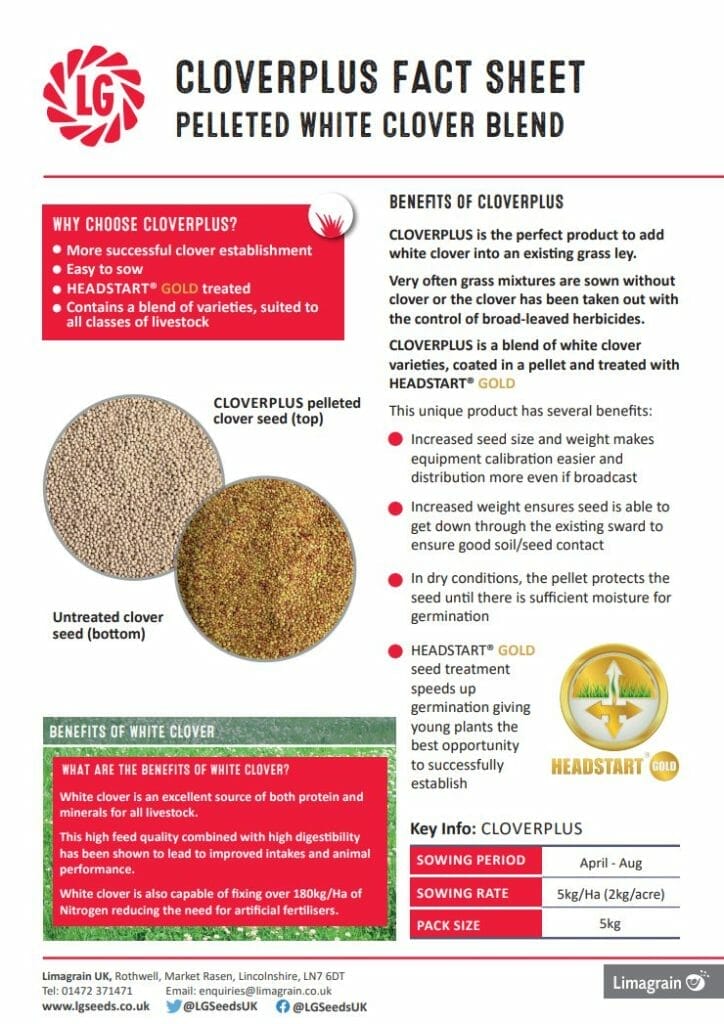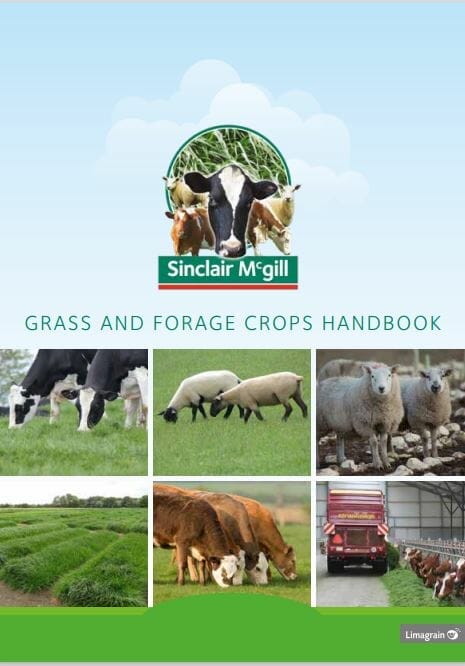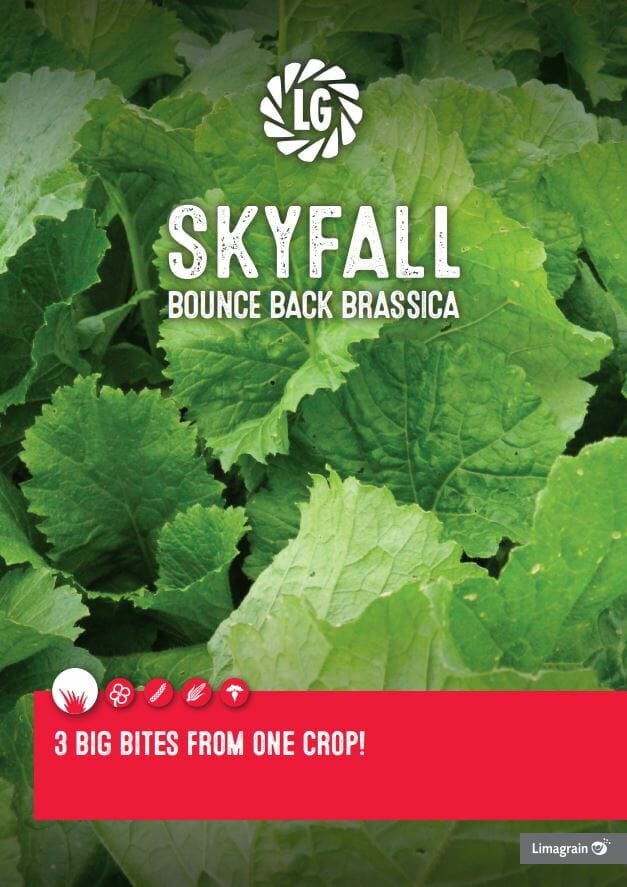A longer growing season, better quality grass and improved pest control support overall forage production, and they are all advantages of following regenerative agriculture principles.
“One key pillar of regenerative agriculture is greater plant diversity,” says Limagrain’s forage crop manager John Spence. “And it’s an area where grassland farmers can reap the benefits by growing mixtures with more species that widen the growing period and help to combat more variable climate conditions.
“For example, clovers continue to grow in mid-summer when ryegrass varieties slow up. This increases the growing season. Clover also offers nitrogen-fixing benefits.”
Likewise, deeper rooted plants included in multi-species mixtures, such as chicory and plantain, will be more productive in drought conditions whilst also improving soil structure and health.
Improve ground cover
Keeping soil covered is another regenerative pillar – and one to focus on for improved grassland productivity. “Mixtures with improved ground cover, dense swards and few bare patches are less prone to poaching in winter on wet land,” he adds. “Including clovers and herbs alongside highly productive ryegrass varieties ensures mixtures are more robust in dry summers with good ground cover, as well as increased forage output and quality.
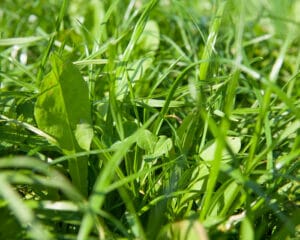 He encourages grassland farmers to avoid leaving swards fallow between reseeds. “We recommend that farmers avoid following grass with grass immediately, particularly if there’s a pest problem, and a six-month break is good. Instead, a winter forage crop such a stubble turnips and forage rape will maintain ground cover, help to break the pest cycle, and provide extra much-needed forage for livestock.”
He encourages grassland farmers to avoid leaving swards fallow between reseeds. “We recommend that farmers avoid following grass with grass immediately, particularly if there’s a pest problem, and a six-month break is good. Instead, a winter forage crop such a stubble turnips and forage rape will maintain ground cover, help to break the pest cycle, and provide extra much-needed forage for livestock.”
One of the main regenerative agriculture pillars is avoiding soil disturbance. “For grassland farmers this means direct drilling of new leys, minimum soil cultivation, and avoiding ploughing where possible. Overseeding is a good way of increasing productivity without cultivation”.
“Mixtures with tetraploid ryegrasses are good here as they complete well with existing grasses.”
Grassland farmers are already following many of the regenerative farming principles, but there’s more to be gained – specialist mixtures, forage break crops and improved practices will both support soil health and add to grassland productivity.
Financial support?
And there’s the added support from new SFI rules that could offer cash payments for making certain improvements, such as “NUM2: Legumes on improved grassland,” which offers £102/ha for introducing legumes such as white clover into existing temporary grass swards.
“It’s a win-win for many grassland farmers – more output from grassland and increased support for regenerative principles will support their businesses’ longer-term sustainability.”
Find out more about our grass mixtures here
Clover is all the rage, but watch the caveatsClover mixes have been in high demand in the past few years. In 2022, Limagrain reported a five-fold increase in demand for its CloverPlus blend.
Forage crop manager John Spence considers this a wise choice, as long as growers adhere to some specific sowing and management ‘rules’ to ensure success.
Few need a recap of the advantages of clover in a grass sward. “Nutritional benefits and nitrogen fixing abilities are big attractions,” says Mr Spence. “Also, its soil health improvement potential and drought resilience add to its benefits.”
He finds it surprising that more farmers and growers haven’t taken advantage of clover until more recent years, particularly as inorganic fertiliser use has been falling on UK livestock farms since the early 1980s.
Nitrogen applications have halved on grassland farms, according to Defra reports, but only 13% of livestock farms include clover in all their leys, and 25% include no clover at all.
“This is surprising when you consider the high protein content of clover and its palatability in grass swards. On farm trials have shown that the D value in grass and white clover swards remains at least 2 points higher than a grass plus nitrogen fertiliser sward throughout the grazing season.”
And clover’s seasonal growth also compliments grass, as shown in Figure 1. It has a deep tap root to withstand drier conditions, so a grass clover sward will have a more even growth pattern through summer.
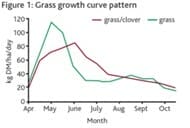
Fig 1
A grass sward with good white clover content can produce as much forage as a grass-only sward receiving 180kg of nitrogen per hectare. “This is equivalent to 520kg of ammonium nitrate fertiliser a hectare and worth about £220 per hectare based on current fertiliser prices of £420/t.”
Red clover is more impressive and can fix up to 250kg of nitrogen per hectare, but even at 200kg per hectare, this is worth £240 a hectare.
White clover is commonly used in grazing leys, though the popularity of red clover in shorter term silage mixtures is growing primarily to increase protein content. Also red and white form a major part of most multispecies and herbal grazing leys.
Mr Spence points out important considerations when sowing clover. “Clover isn’t as vigorous as grass, so it needs careful sowing to promote establishment. The main hurdle is soil temperature. Clover will only grow when soil temperatures are above 8°C, whereas grass will germinate at 5°C. If it’s too cold for the clover, it will be outcompeted by the grass species.”
The combination of needing warmer soil temperature, plus the loss of clover safe herbicides have put growers off using clovers in the past. “Although these issues still remain, an increased focus on soil health and the recent surge in fertiliser prices have seen growers coming back to clover.”
To ensure success, clover is best sown in May or June. It can be oversown into a grass sward that has been cut or grazed tightly, so that competition from the existing sward is minimised.
The ground must be prepared by harrowing to remove any dead thatch, and to ensure good seed to soil contact.
If reseeding is scheduled for late spring, after first cut silage or a first round of grazing, then clover can be included in the grass seed mixture. “But, again, soil temperatures must be high enough and it must be sown into a carefully harrowed fine tilth to speed up its establishment and ensure it can compete with the grasses in the mix.
A biostimulant seed treatment will also help to improve germination.
Clover seed is small, and so has limited energy reserves, making establishment trickier, particularly when sown into the competitive environment of an existing grass sward.
“But establishment rates can be increased significantly (by using a pelleted and treated seed.
“This makes the seed larger and heavier so increasing the likelihood of good soil contact. It also helps to achieve better distribution when the seed is broadcasted, and it is easier to calibrate. Pelleted seed is by far the preferred type of seed for oversowing clover into existing swards.”
Seed choice
There are a range of clover varieties that can be blended to take advantage of the merits of each. White clovers are generally categorised as small, medium or large leaved types.
The smaller leaved varieties are slower to establish and lower yielding but are the most long lasting and persistent under tight grazing. Larger leaved clovers are the fastest to establish and highest yielding but are less persistent.
 “Blends formulated for dairy systems tend to take advantage of the higher yielding medium and large leaved clovers,” he says. “We include 90% medium and large leaved clovers in our pelleted CloverPlus blend and only about 10% of small leaved clover to help increase ground cover and persistency. It also includes the new large leaved New Zealand variety Kakariki which gives exceptional yields.”
“Blends formulated for dairy systems tend to take advantage of the higher yielding medium and large leaved clovers,” he says. “We include 90% medium and large leaved clovers in our pelleted CloverPlus blend and only about 10% of small leaved clover to help increase ground cover and persistency. It also includes the new large leaved New Zealand variety Kakariki which gives exceptional yields.”
Overall, well-managed clovers in the sward will last for the persistency of the mixture. “White clover is very persistent and if correctly managed would last longer than many mixtures,” adds Mr Spence.
“Red clover will last three to four years and so is usually paired with grass species that last the same amount of time. For example, a grass and red clover mixture would tend to include high a proportion of hybrid ryegrass.”
Even at lower fertiliser prices, Mr Spence believes the increase in demand for clover will continue. “Persistency in drier conditions, nitrogen-fixing properties and soil health benefits as well as feed value are high on the radar for dairy farmers going forward,” he says.
Environmental schemes such as SFI are also encouraging the use of clovers, either as part of a legume rich sward, or as a tool for managing grassland with low nutrient input.
“There’s a lot of work going on behind the scenes among seed breeders too, to boost the yield and persistency of clovers, and there are new improved varieties out every year.
“I’d encourage livestock farmers to give it a go, or to introduce more clover if it’s an option, and if the guidelines are followed for ensuring good establishment, the crop will bring many benefits to animal production and to the sustainability of the system.”
Find out more
To download the CloverPlus fact sheet, click here
Start your grass planning now!
Start your grass planning now!
Autumn can be an excellent sowing period to establish a new reseed, especially if your existing paddocks look like they are running out of steam!
A few simple steps before sowing can make a huge difference:
1. A pH of 6.0 to 6.5 (for clover leys) is ideal
2. Prepare a firm fine seedbed 5-8 cm deep
3. Ring roll to ensure moisture retention and an even drill depth
4. Drill with a harrow/seeder no deeper than 6mm
5. Rolling after makes a big difference
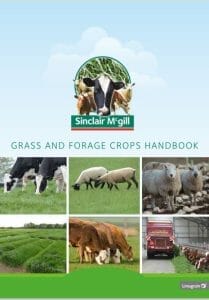 We recommend using Sinclair Mcgill seed mixtures:
We recommend using Sinclair Mcgill seed mixtures:
Castlehill – A long term dual purpose permanent pasture with clover
Turbo – Ideal for paddock grazing systems, fast regrowth and longer grazing periods.
Colossal silage – a shorter term mixture to produce quality silage yields.
Click here to find your local Sinclair McGill distributor!
Back your grassland
Grassland improvement is always a wise investment and despite some hikes in input prices there’s still no question on the payback from a reseed or repair.
Early summer is a key time in the grassland calendar. It’s when ‘big’ decisions are made – like timing of silage cuts to achieve the best quality or to maximise yield to fill the clamp.
“But it’s also time to assess sward and grass quality and make some decisions,” says Limagrain UK’s forage crops product manager John Spence. 
So once first cut is completed, a visual assessment of the swards, together with yield and initial quality details, will give a good indication of whether silage targets have been met.
Fertiliser ‘fix’
If yields are down and the silage clamps are low after first cut then sward growth should be maximised in the short term.
“It might be a hard pill to swallow this year, but even with high input prices, the additional grass yield gained from fertilizer applications is worthwhile and more cost-effective than making up the shortfall in dietary energy with bought-in feed,” says Mr Spence.
Whilst reducing fertiliser applications might seem like an attractive idea, a 25% cut in nitrogen from an annual rate of 250kg/ha to around 185kg/ha is likely to reduce grass yields by around 2t/ha equivalent to a reduction in energy of around 22,000MJ/ha. This might save around £80/ha in fertiliser costs but the loss in energy from grass will cost around £600 to replace from energy in bought-in concentrates.
“And remember, concentrate feed prices are still high, so most farmers will see maximising milk from high quality forage as even more important this year.”
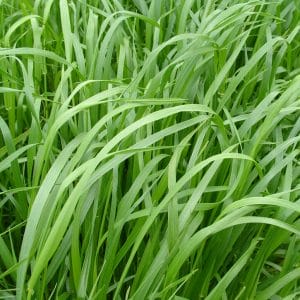 Oversowing the sward with a grass seed mixture – or clover – is another short to medium term grass improvement option, and soon after first cut is a good time to do this on any swards needing some ‘repair’.
Oversowing the sward with a grass seed mixture – or clover – is another short to medium term grass improvement option, and soon after first cut is a good time to do this on any swards needing some ‘repair’.
“Have a walk around the sward a few days after cutting it,” adds Mr Spence. “Look for gaps and broadleaved weeds. But also look at the grasses. There’s no need to worry about identifying the individual grass weeds but look for the proportion of ryegrass in a sward.”
Ideally, 70% of the grass plants should be ryegrass. If there’s less, productivity begins to be significantly compromised. “Examine a metre square area and work out the ryegrass population,” he adds. “If there’s between 70% and 80% perennial ryegrass content then overseeding – rather than a full reseed – can renovate a ley and extend its productive life.”
Correct mixture choice for overseeding is important as the newly sown grasses need to compete with the existing sward. A high inclusion of Tetraploid grasses is recommended as they tend to be larger seeded and more competitive with the established plants.
“Overseeding is also a great way of introducing or increasing the clover content in the sward,” he adds. “Sowing clover in May and June, when soil temperatures have warmed up, means the clover should establish quickly and be able to better compete with surrounding grasses. A pelleted clover, with a mix of clover leaf sizes, gives best results.”
Grass ‘shelf-life’
Grass leys are at their most productive in their first year – so a sward sown in 2023, should be at its most productive in 2024. “Fall off is gradual but inevitable. By year five, a ley’s productivity could be just 60% of year two and the dry matter yield from a grass sward can decrease by about five tonnes/ha from year 1 to year 4.
Ideally, 20% of grassland should be reseeded each year. This keeps grassland on a five year rota and offers the opportunity to maximise sward productivity. 
Even with higher fertiliser and fuel prices, Mr Spence says that the cost of a reseed is easily justified and will pay for itself in improved output from the sward in little over a year.
“It costs between £550 a hectare and £850 a hectare to reseed, depending on whether it’s an overseed or a full reseed,” he says. “But the dry matter output and forage quality should be significantly improved. The new ley should produce more than 33,000MJ per hectare of energy, which is enough to produce 6300 litres of milk. At 40p a litre, this is more than £2500 in milk value. So there’s no issue over justifying the cost.”
He points out the value of choosing a high quality tried-and-tested grass seed mixture suited to the farm and the sward’s purpose makes economic sense.
“It costs the same to sow an average grass seed mixture and a high quality proven mixture. Between 25% and 30% of the reseed cost will be spent on seed, if you opt for a high quality mixture, or around 20% for a standard mixture” he says.
“So there’s a marginal difference in price but on farm trials with new varieties and mixtures show a big difference in yield and feed value which farmers can take advantage of.”
Reseed timing
Reseeding in spring tends to be less popular than in autumn, primarily because it means taking a field out of production during peak grass growing time, despite warmer conditions favouring good establishment and less chance of competition from weeds.
“Less availability of pesticides has altered reseeding decisions. We can’t rely on their use in reseeds, so instead we’re looking more to a rotation to break the bug cycle to help ensure a successful reseed.”
 One option may be a quick growing brassica such as Skyfall, sown in May after first cut silage and giving several high protein rounds of grazing, starting as early as late July when the grass growth has slowed down. “We call this crop a bounce-back brassica as it can be grazed, closed up and after an eight-week regrowth, re-grazed ahead of an autumn reseed.”
One option may be a quick growing brassica such as Skyfall, sown in May after first cut silage and giving several high protein rounds of grazing, starting as early as late July when the grass growth has slowed down. “We call this crop a bounce-back brassica as it can be grazed, closed up and after an eight-week regrowth, re-grazed ahead of an autumn reseed.”
For those looking for a second cut or grazing round prior to a reseed, a kale or brassica hybrid or stubble turnips sown in July or August will provide a grazing crop in autumn and winter ahead of a spring reseed.
“There are lots of options when it comes to maximising output from grassland, and cutting costs in this area is false economy. There are many other areas to look at before making cuts here.
“And bear in mind that reseeding, oversowing and fertiliser use go together. Younger, healthier grasses will make better use of fertiliser applications than older swards, which means that more fertiliser is turned into grass and feed value in a healthy fresh grass sward.”
Find out more
To see the full range of Sinclair McGill mixtures and find your nearest distributor, click here
To download the Sinclair McGill Grass and Forage Handbook, click here
To find out more about LG Skyfall Bounce Back Brassica, and download a free Growers’ Guide.
Choosing grass seed mixturesReseeding – or at least overseeding – every five years is essential for dairy farmers taking grassland productivity seriously.
This costs between £550 a hectare and £850 a hectare, according to Limagrain UK’s forage crop manager John Spence.
“Of this, between 25% and 30% will be spent on seed, if you opt for a high quality mixture, or around 20% for a standard mixture” he says, adding that cutting corners here amounts to a false economy.
“There’s a big difference between a good and a standard seed mixture, in yield and feed value,” he adds, “yet it costs the same to carry out the work and only a small difference in seed costs.
“And there’s a great deal of knowledge and skill that goes into designing our best seed mixtures, and into the testing and trial work before they even hit the shelves. Farmers would be foolish to dismiss this.”
The UK’s Recommended Lists are compiled annually by a panel of industry specialists. There’s a constant influx of new varieties pitching for a place on this list.
Be discerning when choosing seed mixtures
“The selection process is pretty robust though,” adds Mr Spence. “A newcomer has to show a clear improvement on existing varieties, based on extensive trials, before being accepted, such as yield, metabolizable energy, D value and ground cover.”
 There are also secondary characteristics that are considered, more specific to the type of grass, such as disease resistance, and seasonal yield, and winter hardiness.
There are also secondary characteristics that are considered, more specific to the type of grass, such as disease resistance, and seasonal yield, and winter hardiness.
Much of the forage quality trial data used by the selection panel is based on results in the early growing season; something Limagrain is keen to complement with its own data from trials that run throughout the whole growing season.
“The more data we have, the better we can understand a variety’s strengths, so we use the recommended list trial data alongside our own before selecting varieties for our mixtures,” he adds. “We compare varieties on their seasonal performance and also their year on year results, so we take their lifetime performance into account.
“This additional data highlights the ‘staying power’ of the variety right across the season, so it’s important information for growers, and for us as we select varieties for our mixtures.”
Pick and mix
The second, and equally important stage, in selecting the right grass seed is choosing a mixture of varieties that work well together. Designing these mixtures lies with the individual grass seed companies and the mixture’s success is dependent on their skill and expertise.
 These mixtures should build on the characteristics of individual varieties, particularly when it comes to yield. “But the varieties should also complement each other, and this will be particularly evident in feed value. This is an increasingly important component of home-grown forages in the light of record highs for bought-in feed prices,” says Mr Spence.
These mixtures should build on the characteristics of individual varieties, particularly when it comes to yield. “But the varieties should also complement each other, and this will be particularly evident in feed value. This is an increasingly important component of home-grown forages in the light of record highs for bought-in feed prices,” says Mr Spence.
“It’s important to use the right ingredients – or varieties – for each mixture, depending on its purpose. For example, the varieties used in a cutting mixture should prioritise yield while maintaining high feed value at silage time, whereas varieties for grazing need to perform throughout the season, with dual-purpose mixtures s carefully balancing the two key parameters.”
Put to the test
Limagrain compares its own mixtures and other commercially marketed mixtures in field trials. It’s been running since 2013, when it introduced a yield and feed value stamp of approval to the best; those achieving high performance in both areas.
“We’re the only company in the UK to have a bank of data on the performance of grass seed mixtures that is updated annually. It’s enables merchants and farmers to check out the latest ranges”.
The feed value of grass mixtures is measured using near infra-red – NIRS – spectroscopy. “We have a benchmark for energy, sugar, protein and digestibility components. Mixtures achieving or surpassing these, and meeting our benchmarks for yield, carry the LGAN accreditation.” 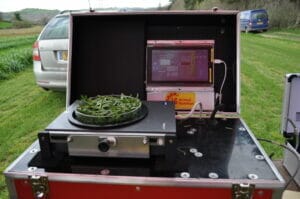
Popular mixtures for dairy farmers that carry the LGAN accreditation in the company’s Sinclair McGill range include Colossal Silage – a short term ley for cutting, dual-purpose Prosper and one of the best grazing mixtures available, Turbo.
“Take Turbo, this has five perennial ryegrasses in its mix – two intermediate and three late varieties. Within these are three tetraploids and two diploids. It also includes the grazing Festulolium Matrix and a white clover blend.
“So we have species that can withstand drier conditions, have exceptional yield characteristics, can fix nitrogen and provide growth through the season. And the Matrix grows at cooler temperatures so gives ‘shoulders’ to the crop in spring and autumn. And collectively this mix meets the LGAN combined feed value and yield benchmarks.”
Trial results show the value of improved grass seed mixtures. For example, the relative dry matter four-year mean yield for Turbo was 4% above the control, and the four-year mean sugar (WSC) content to digestible fibre (dNDF) placed Turbo ahead of the other mixtures on the trial, as shown in Figure 1.
Fig. 1 Four year sugar (WSC) (%) vs dNDF (%)
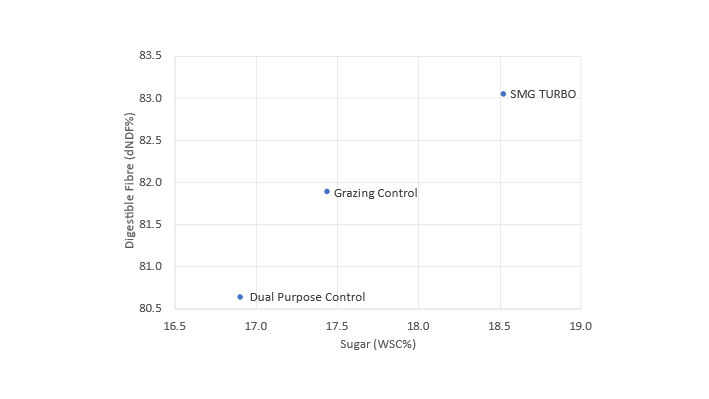
Figure 2 shows the added value of high feed value seed mixtures in milk income. “An extra 1% in digestible fibre from forage can add 0.25kg of milk a day, and based on the performance of Turbo across four years, this gave an additional £81 per cow per year based on 300 milking days.
“The benefit is even higher when we consider savings from bought in feeds and a higher milk price.”
Fig 2. Turbo vs Long term dual-purpose ley – performance 2017-2022
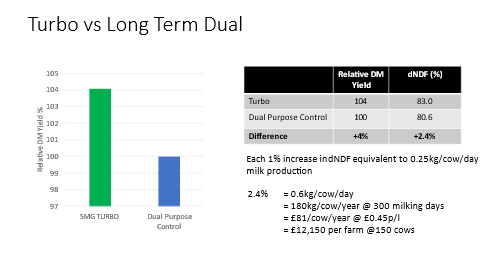
Quality control
No ‘full package’ seed mixture would be complete without quality checks. If you buy a premier seed mixture you expect high quality clean seed,” adds Mr Spence. “There are legal standards for germination and purity and there are higher voluntary standards.”
The standard level for germination is 80% and 96% of the seed must be pure. The higher voluntary level for purity is 98%. Limagrain adds another 10% to this germination level and tests seed every six months to make sure standards are maintained. 
A top quality grass seed mixture could cost £230 a hectare, for example, compared with a standard of the shelf mixture at £175 a hectare, at a standard sowing rate of 35kg of seed per hectare for a reseed.
If there’s a difference of 10% in germination and 2% in purity, this brings the cost per viable seed to a similar cost. But the higher quality mixture will have the yield and feed value assurances too.
“So farmers can afford to be discerning and spend their money on a mixture with a pedigree – a background of reliable recommended varieties, with supporting trial data compiled into a mixture that is proven to do the job they want it for.”
Top Tips
- Know what you want the sward for – grazing, cutting, dual-purpose?
- Review your own farm’s growing season
- Look at a mixture’s ‘pedigree’ – trial data, yield and feed value characteristics, quality and germination assurances
- Avoid mixtures with limited information on varieties and/or lack of trial data in UK conditions
Find out more
To see the full range of Sinclair McGill mixtures and find your nearest distributor, click here
To download the Sinclair McGill Grass and Forage Handbook, click here
Weighing up grass mixturesAre multispecies seed mixtures a silver bullet or are there other options to consider when reseeding grassland?
Multispecies grass mixtures have grown in popularity in recent years, with sales at least doubling year on year since 2019. And for good reason, says Limagrain UK’s forage crops manager John Spence. But he suggests growers weigh up the pros and cons, look at alternatives, and decide what’s right for their own situation.
“Multispecies mixtures tick a lot of boxes, offering numerous benefits, but when reseeding, growers shouldn’t be quick to discount a good ryegrass and clover mixture. These can bring many of the same benefits, along with other advantages that might suit some situations better.’
He says that in many cases, multispecies are compared with a ryegrass-only swards, and the benefits of drought resistance, lower inputs and more continuous summer growth shine through in mixtures with a wider range of varieties and herb species.
“But if you add clover to the ryegrass mix, you bring some of the benefits of a multispecies mixture such as a reduced fertilizer need and more continuous growth through summer. Plus a few more advantages, such as flexibility of use and longevity, that might appeal to some.
 “For example, ryegrass and clover mixtures are better for dual purpose use. They can be cut for silage earlier in the season, then closed up and grazed,” he says, adding that while it’s not impossible to use a multispecies mixture for cutting, they tend to be more difficult to manage.
“For example, ryegrass and clover mixtures are better for dual purpose use. They can be cut for silage earlier in the season, then closed up and grazed,” he says, adding that while it’s not impossible to use a multispecies mixture for cutting, they tend to be more difficult to manage.
“If multispecies swards are destined for cutting, they’re best treated as a multicut crop so the chicory doesn’t get too woody and undigestible.”
Likewise, there’s little margin for error in the grazing management of multispecies swards if their feed value is to be realised.
“Grazing multispecies swards too tightly will reduce the persistence of the herbs, but if it’s left to grow too long, herbs such as chicory will become woody. It’s not quite as straight-forward as a ryegrass and clover sward.”
But the inclusion of herbs such as the deep-rooted chicory and plantain in multispecies swards do add drought-tolerance benefits and contribute to soil health and structure. “These can be very valuable in areas with light soils, and where drought conditions are common.
“But in less extreme areas, tetraploid perennial ryegrass can be added to a grass and clover mixture. These are deeper rooted than diploid varieties and can withstand dry conditions better, and tend to be higher yielding and more digestible.
Likewise, he points out that all grass swards benefit soil health and structure and are an ideal addition to a cropping rotation. Remember too that including clover in a ryegrass mixture brings nitrogen-fixing benefits and offers a more consistent growth pattern through summer.”
And if extending the grazing season is a priority, both grass/clover and multispecies mixtures can be formulated to include species such as Timothy and Festulolium which start growing at lower temperatures than ryegrasses. “This adds ‘shoulders’ in spring and autumn and extends the grazing season,” he says.
Herb longevity
Some herb species claim anthelmintic properties to mitigate the worm burden in livestock whilst also adding feed value, in addition to their deep roots that enhance soil structure and grow in drier conditions.
Which species to include in a multispecies mixture is something Mr Spence says growers should also consider carefully. “The mixtures can get very complicated, and can include 15 to 20 different components, some of which will be more difficult to establish.” 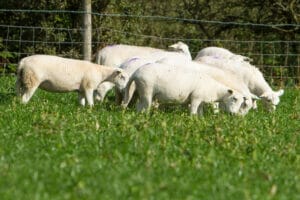
Typically herb species such as plantain and chicory establish well across a wide range of soil types and work well in combination with productive grass species such as ryegrasses, Festulolium and Timothy. Other herb species such as sainfoin and sheeps parsley are much more difficult to establish successfully.
“Grass chicory and plantain, with red and white clover, are the simplest and maybe most reliable multispecies mixtures. If more complex mixtures are being considered, and these are generally more expensive, growers should get local advice on their suitability to the area and its soils, and the track record of establishment of the various varieties. Otherwise you might be paying for something you never see.”
The persistency of the herbal varieties will also affect sward longevity. “The herbs tend to die out quicker than the grasses and clover,” adds Mr Spence. “If we get four years from a multispecies sward we’re doing well. By then most herbs will have been ‘pushed’ out by the more competitive grass varieties with just the ryegrass and clover surviving.”
A ryegrass and white clover sward reseed should last for five years. “There’s a significant difference here with a multispecies sward, so this needs to be considered when costing a reseed.”
 The environmental aspects of multispecies swards and its ability to attract a diverse range of wildlife has attracted some growers to these options. “And a main driver has been the countryside stewardship payments for crops grown in England meeting certain criteria. If the mixture complies with the rules and the crop meets the growing requirements it can attract £382 a hectare.
The environmental aspects of multispecies swards and its ability to attract a diverse range of wildlife has attracted some growers to these options. “And a main driver has been the countryside stewardship payments for crops grown in England meeting certain criteria. If the mixture complies with the rules and the crop meets the growing requirements it can attract £382 a hectare.
“It’s all about managing risk and balancing the conditions on the farm with the requirements from the crop, and working out which mixture will be the best match.”
Multispecies or a glass clover mixture – Considerations
• Soil type, weather conditions/drought risk
• Grazing only or cutting/grazing requirements
• Grazing management resource
• Input requirements/availability of slurry
• Productivity and persistency through the season
• Sward longevity
• Eligibility for and attractiveness of conservation /environmental schemes
Sinclair McGill’s medium term grass seed mixture, Prosper, is showing its colours as a high yielding and high value grass seed mixture.
In Limagrain field trials, carried out from 2017 to 2020 at its UK Innovation site Prosper led the field for key yield and quality attributes when compared with other Sinclair McGill mixtures and two premium controls. This mixture has continued its success in 2020 and 2021 field trials, despite challenging growing conditions.
Top yield
Prosper had excellent performance when cut for silage with yields exceeding any other perennial ryegrass based mixture. Its dry matter yield was even higher yielding than the control short term mixture composed of Italian and Hybrid ryegrasses. A short term mixture is normally expected to surpass a medium term mixture in dry matter yield.
Four-year Mean Relative DM Yield (t/ha)
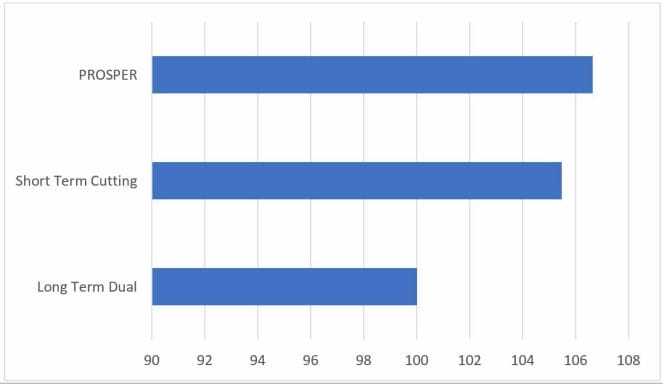
This mixture also had the highest sugar content (WSC %) among the mixtures on trial and a digestible fibre (dNDF) 2% above the long term mixture control. Prosper’s four year average mean metabolisable energy (ME) was the best in the group.
Top dry matter
In a grazing management situation, Prosper’s relative dry matter yield across the four years was significantly above the controls when cut under a simulated grazing regime. It also produced some of the best sugar, energy and digestible fibre results, similar to that of Sinclair McGill’s high quality grazing mixture Turbo.
Four-Year mean WSC (%) vs dNDF (%)
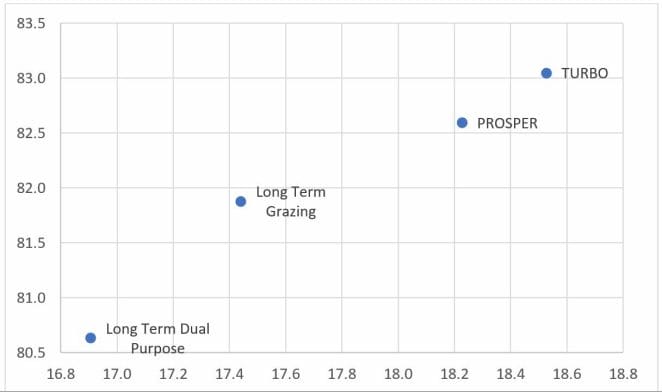
Best of both
Prosper is a dual purpose mixture comprising mid and late perennial ryegrasses and tetraploid ryegrass varieties. The mixture also includes white clover and, for Scotland and Northern Ireland, a small amount of Timothy. This combination of varieties at carefully formulated ratios makes the mixture ideal for grazing cattle and for conservation.
High yields and high feed value, particularly dNDF, combine to put Prosper ahead as a top dual purpose cutting and grazing mixture.
LGAN quality accreditation
Prosper carries Limagrain’s LGAN (LG Animal Nutrition) accreditation. This rubber-stamp confirms its yield and feed value. It reflects the merits of the individual varieties included in the mixture and their abilities to complement each other within the mixture.
 The LGAN stamp is ‘proof’ that the mixture has met both agronomic and feed value benchmarks and that, through extensive trials, it has a track record for efficient production.
The LGAN stamp is ‘proof’ that the mixture has met both agronomic and feed value benchmarks and that, through extensive trials, it has a track record for efficient production.
The ability to improve digestible fibre (dNDF) has been a key factor in selecting LGAN varieties and mixtures. Fibre is needed in the diet to maintain a healthy rumen, so increasing dietary dNDF improves feed efficiency.
In dairy cattle even a small increase in dNDF has been linked to improvements in both intakes and milk production. Similar performance advantages can be expected in increased intakes and liveweight gain in beef cattle.
LGAN PROSPER, dual purpose (Sinclair Mcgill)
- 58% Mid season perennial ryegrass including tetraploid varieties
37% Late perennial ryegrass including tetraploid variety
5% White clover blend
(Mixture for Scotland and Northern Ireland includes 7%Timothy – slightly lower quantities of ryegrasses)
Reseed – with quality
Grass swards are at their most productive in their first year. Dry matter yield and energy content of the grass will then decline year-on-year.
Limagrain’s latest grass trial results have confirmed this and have demonstrated the yield benefits of the younger sward, and of high quality grass seed mixtures verses a control.
These latest trial results, that show an average decrease in yield of nearly five tonnes per hectare – around 40% – from year one to year four reinforce the value, and cost-justification, of reseeding as part of good farm management.
Adding further value to the reseed is achieved by using high quality, top-performing mixtures that are identified in the trial.
More information
Find your nearest Sinclair McGill distributor here
To learn more about Sinclair McGill Prosper mixture, click here






























 To ensure success, clover is best sown in May or June. It can be oversown into a grass sward that has been cut or grazed tightly, so that competition from the existing sward is minimised.
To ensure success, clover is best sown in May or June. It can be oversown into a grass sward that has been cut or grazed tightly, so that competition from the existing sward is minimised.